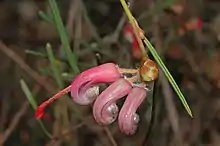Grevillea fulgens
Grevillea fulgens is a species of flowering plant in the family Proteaceae and is endemic to an area near Ravensthorpe in the south-west of Western Australia. It is a spreading to straggling shrub with simple or pinnatifid leaves, and deep pink or reddish flowers.
| Grevillea fulgens | |
|---|---|
 | |
| In the Australian National Botanic Gardens | |
| Scientific classification | |
| Kingdom: | Plantae |
| Clade: | Tracheophytes |
| Clade: | Angiosperms |
| Clade: | Eudicots |
| Order: | Proteales |
| Family: | Proteaceae |
| Genus: | Grevillea |
| Species: | G. fulgens |
| Binomial name | |
| Grevillea fulgens | |
Description
Grevillea fulgens is a spreading to straggling shrub that typically grows to a height of 0.5–3 m (1 ft 8 in – 9 ft 10 in) but does not form a lignotuber. Its leaves are linear, 40–110 mm (1.6–4.3 in) long and 1–4 mm (0.039–0.157 in) wide, sometimes with a few teeth, or pinnatifid with up to eleven more or less triangular lobes 1–5 mm (0.039–0.197 in) long and 1.0–1.5 mm (0.039–0.059 in) wide. The edges of the leaves are rolled under, obscuring most of the lower surface. The flowers are arranged singly or in small groups in leaf axils or the ends of branches on a rachis 0.5–2 mm (0.020–0.079 in) long. The flowers are deep pink or reddish and partly hairy, the pistil 23–26 mm (0.91–1.02 in) long, the style red. Flowering occurs from June to October and the fruit is an oval follicle 12–15 mm (0.47–0.59 in) long.[2][3]
Taxonomy
Grevillea fulgens was first formally described in 1964 by Charles Gardner in the Journal of the Royal Society of Western Australia.[4][5] The specific epithet (fulgens) means "shining".[6]
Distribution and habitat
Grevillea fulgens grows in shrubland or mallee heath in shallow gravelly soil on laterite, and is found in an area near Ravensthorpe in the Esperance Plains bioregion of south-western Western Australia.[2][3] It is known to be a disturbance opportunist in the gravel soils of the Ravensthorpe Range.[7]
Conservation status
Grevillea fulgens is classified as "Priority Three" by the Government of Western Australia Department of Biodiversity, Conservation and Attractions,[3] meaning that it is poorly known and known from only a few locations but is not under imminent threat.[8]
See also
References
- "Grevillea fulgens". Australian Plant Census. Retrieved 24 April 2022.
- "Grevillea fulgens". Australian Biological Resources Study, Department of Agriculture, Water and the Environment: Canberra. Retrieved 24 April 2022.
- "Grevillea fulgens". FloraBase. Western Australian Government Department of Biodiversity, Conservation and Attractions.
- "Grevillea fulgens". APNI. Retrieved 24 April 2022.
- Gardner, Charles A. (1964). "Contributiones Florae Australiae Occidentalis, XIII". Journal of the Royal Society of Western Australia. 47 (2): 55–56. Retrieved 24 April 2022.
- Sharr, Francis Aubi; George, Alex (2019). Western Australian Plant Names and Their Meanings (3rd ed.). Kardinya, WA: Four Gables Press. p. 202. ISBN 9780958034180.
- Nathan McQuoid (20 September 2003). "Reasons for Richness The Nature of the Fitzgerald Biosphere Flora" (PDF). Natural Heritage Trust. Retrieved 6 August 2016.
- "Conservation codes for Western Australian Flora and Fauna" (PDF). Government of Western Australia Department of Parks and Wildlife. Retrieved 24 April 2022.
